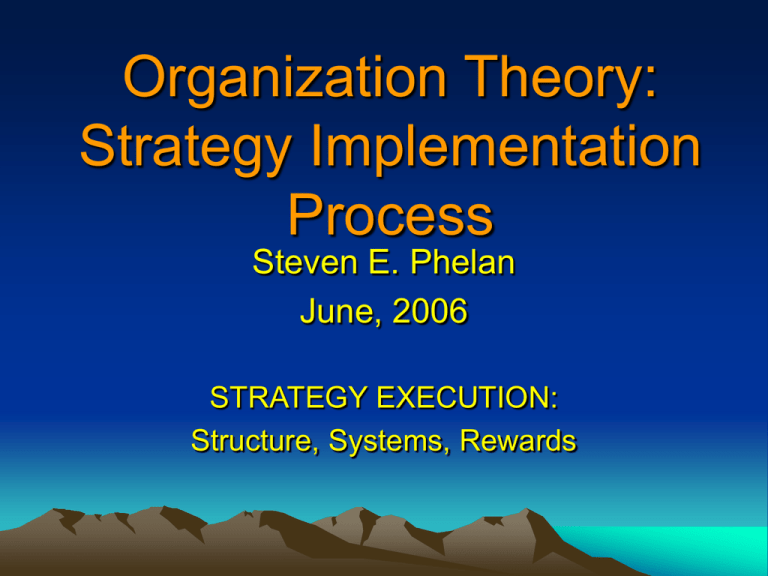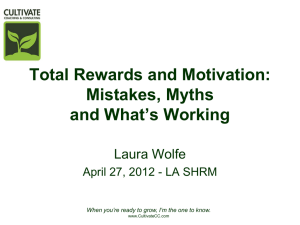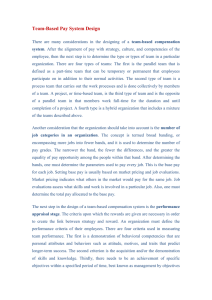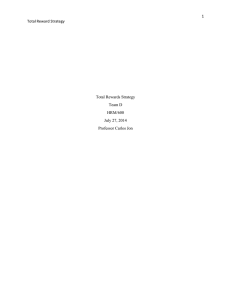Corporate Strategy
advertisement

Organization Theory: Strategy Implementation Process Steven E. Phelan June, 2006 STRATEGY EXECUTION: Structure, Systems, Rewards Overview • Syriana Discussion • Structure and Execution Hrebiniak Chapter 4 USA Today • Integration Hrebiniak Chapter 5 Brache – Strategy implementation Bossidy- Letter to a new leader AHA • Incentives and controls Hrebiniak Chapter 6 Bebchuk – Pay without performance Syriana • Analyze the movie from the perspective of: Chaos and complexity theory Critical theory Corporate social responsibility The Star Model Strategy People Structure Rewards from Galbraith, Designing Organizations Processes (Integration) Structure • Key principles Functional organization -> efficiency • Economies of scale, avoids duplication, critical mass of know-how, clear career path Divisional structure -> effectiveness • Traditional focus on products, markets or geography • New areas – customers, processes, solutions, segments • Profit contribution can be easily measured in product divisions – Does this provide more monitoring/motivation as well? Centralization v Decentralization • General principle Centralized = functional/efficient Decentralized = divisional/effective • Text recommends a sequential process starting from the corporate level to group, division, and strategic business unit (SBU) • Choice depends on what is important to management Tall v Flat Large, more centralized companies often have taller structures (I.e. more layers) Increasing the span of control to create flatter structures can create benefits • Faster decision making, less bureaucracy, closeness to customers, cost savings, and flexibility but can also suffer from problems such as: • inertia, inadequate expertise, lack of responsibility, and lateral communication problems • Not a universal cure all Corporate HQs are starting to include: • Strategic management functions, executive education, and “centers of excellence” in addition to traditional HR, legal, IT etc. Strategic Drivers • Type of strategy Global strategy often calls for matrix structure Low cost leadership = functional structure Focus/differentiation = divisional structure • Market and technological relatedness Same customers, processes, distribution etc. Leads to increased centralization (or need for coordination) • Growth/size Increased decentralization Emerging Trend • Customer centric mindset To find as many new and existing products to sell to a customer as possible To create and customize solutions for a customer To appear as one company to each customer To develop an on-going customer relationship Contrasted with a product-centric company whose mission is to find as many uses and customers for each product as possible Customer-focused structure • The front/back structure Front End = customers and market Back End = products and technologies Example of a hybrid structure Telstra • Customer Divisions Sales, direct marketing, sales engineers Corporate, Government, Business, Residential • Product Management Product marketing and product engineers Basic access, DSL, prepaid cellphones • Network Engineering Technologies, platforms, infrastructure Switching, transmission, access Broadband, wireless, microwave Thoughts • Art or science? Is organizational design more art than science? Diversity (in customers, technology, distribution etc. ) is grounds for differentiation Need to choose primary form of departmentalization Integration processes can compensate for inherent weaknesses Need to be aware of pros and cons Case 1: American Heart Association • Case Study Was the first restructure a sound move? What problems did it create? As an org design consultant, what changes would you recommend to the existing structure… • At the regional level? • At the national level? Integration • Interdependence Pooled • Low coordination requirements • Rules/SOPs/Hierarchy Sequential • High coordination • Scheduling, JIT, transfer pricing issues Reciprocal • Very high coordination • Meetings, trust, group incentives More integration ideas • Voluntary (or informal) Rotation, interdepartmental events, co-location, mirror image departments, consistent rewards, common language • E-coordination Web pages, databases, CRM, email, discussion groups, instant messaging/chat • Formal group Regular meetings – need for leadership/conflict mgt skills More integration ideas ctd. • Full-time integrators Project managers, brand managers, process managers etc. Put teams together across departments • Matrix organization Level of coordination grows but so does cost and difficulty of implementation What about tie-breakers and two-boss bosses? GE’s Workout program? Responsibility Plotting • Responsibility Matrix Major tasks by key people R = responsibility A = accountability (final say) I = must be informed C=must be consulted ? = don’t know • Useful tool Brache v Bossidy • Systems of strategy implementation Brache is more structural (hard) • Establish an initiative identification & priority setting system (to favor fewer initiatives), • Put in place the right structure, people (sponsors, leaders, teams), and culture to support implementation initiatives • Create a reporting system to monitor progress on initiatives Bossidy is people oriented (soft) • Know yourself, know your people (potential & performance of top 1/3), know your customers • Be open, honest, realistic – always learn • Attract, reward, retain the doers (the A-players) that get things done What works? Rewards & Controls • Hrebiniak’s prescriptions Develop and use good objectives • Clear, relevant, measurable Reward the doers Reward cooperation Face the brutal facts honestly Clarify responsibility and accountability Obtain timely and valid information Use the information for learning and adaptation • Take action when actual results deviate from plan • Be sure to change as a result of lessons learned Case 2: USA Today • Identify the problem(s) • Recommend: A strategy A structure A set of key lateral processes, and A reward system That will solve (or at least address) the problem(s) at USA Today Bebchuk and Fried • CEO compensation Critical analysis (compare to Chomsky) • Aggregate compensation of top-five executives 10%+ of earnings of public firms Limits on board independence to set rewards • • • • • Incentive to be nominated/re-elected CEO’s power to benefit directors Friendship, loyalty, collegiality, authority, solidarity Small personal cost of favoring CEO Ratcheting Dubious practices • A list Camouflage and stealth compensation • To reduce ‘outrage’ costs Gratuitous goodbye payments Windfall compensation • Options tend to reward broad market movements and shortterm spikes Pension and deferred compensation • Is the system broken? Are we rewarding executives too much? Will there be a backlash?







